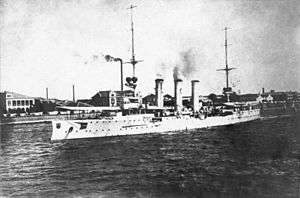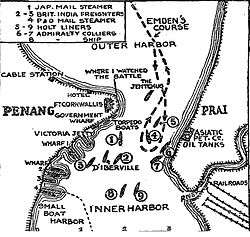Battle of Penang
| Battle of Penang | |||||||
|---|---|---|---|---|---|---|---|
| Part of World War I | |||||||
 Emden | |||||||
| |||||||
| Belligerents | |||||||
|
|
| ||||||
| Commanders and leaders | |||||||
|
|
| ||||||
| Strength | |||||||
|
|
| ||||||
| Casualties and losses | |||||||
|
1 protected cruiser 88 killed, 121 wounded[1] 1 destroyer 47 killed, 36 wounded[2] | none | ||||||
The Battle of Penang occurred on 28 October 1914, during World War I. It was a naval action in the Strait of Malacca, in which the German cruiser SMS Emden sank two Allied warships.
Background
At the time, Penang was part of the Straits Settlement, a British Crown colony. Penang is an island off the west coast of Malaya, now the present day Malaysia. It is only a short distance from the mainland. The main town of Penang, George Town, is on a harbor. In the early months of the war, it was heavily used by Allied naval and merchant vessels.[3]
Shortly after the outbreak of the war, the German East Asia Squadron left its base in Tsingtao, China. The squadron headed east for Germany, but one ship, the light cruiser SMS Emden under Lt. Commander Karl von Müller was sent on a solitary raiding mission.[3]
Battle

 |
|
| Problems playing this file? See media help. | |
At about 04:30 on 28 October, Emden appeared off the George Town roads and attacked the harbor and vessels lying therein. Captain von Müller had disguised his ship by rigging a false smoke stack, which made Emden resemble the British cruiser HMS Yarmouth (1911). Once he had entered the harbor, however, he ran up the German naval ensign and revealed what ship the newcomer actually was. Before any of the Allied naval vessels could respond, a torpedo was fired at the Russian protected cruiser Zhemchug, followed up with a salvo of shells which riddled the ship. As Zhemchug returned fire, a second torpedo was fired. The torpedo penetrated the forward magazine, causing an explosion that sank the Russian ship.[1]
Returning to the harbour from a patrol was the French destroyer Mousquet, under the command of a Lt. Théroinne. The Mousquet set off in pursuit of Emden, but was quickly sunk by the German ship. Casualties amongst Zhemchug's crew of 250[4] amounted to 88 dead and 121 wounded.[5]
Aftermath
The Zhemchug was tied up in a state of non-readiness while her captain, Cmdr. Baron I. A. Cherkassov, went ashore that night to visit his wife (some sources say mistress). The keys for the ship's magazine had been taken ashore and no lookouts had been posted. Cherkassov could only watch in helpless horror from the Eastern & Oriental Hotel as his ship sank to the bottom of the Straits. He was court-martialled for negligence and sentenced to 3½ years in prison, reduction in rank and expelled from the navy; his deputy, Lt. Kulibin, was sentenced to 1½ years in prison. However, Tsar Nicholas II changed both sentences to sending to the front as ordinary seamen. Both men later distinguished themselves in combat and were decorated with the Cross of St. George.[6]
Lt. Théroinne was amongst the Frenchmen lost aboard the Mousquet. Thirty-six French survivors out of a crew of 80 from the destroyer were picked up by the Emden, three of whom later died from their injuries. They were buried at sea at the insistence of von Müller.[2] Two days later, the Germans stopped the British steamer Newburn and transferred the remaining Frenchmen so that they could be conveyed to Sabang, Sumatra, then part of the neutral Dutch East Indies. Emden continued its raiding mission for another 10 days, before being severely damaged and run aground at the Battle of Cocos.[3]
Legacy
A total of 12 Russian sailors are buried on Penang and Jerejak. The monument honouring the sailors of Zhemchug was twice renovated by Soviet sailors in 1972 and 1987 respectively. The battle was mentioned numerous times by Vladimir Putin on his 2003 presidential visit to Malaysia. The Russian embassy in Malaysia holds memorial services twice annually in honour of the fallen sailors.[1][7]
See also
Footnotes
- 1 2 3 "Tragedy in Penang". Retrieved 26 August 2014.
- 1 2 "SMS Emden". Retrieved 26 August 2014.
- 1 2 3 Kaiser's Pirates. Retrieved 26 August 2014.
- ↑ "The war on the sea". The Independent. Nov 9, 1914. Retrieved July 24, 2012.
- ↑ "Sinking of Zhemchug". Retrieved 26 August 2014.
- ↑ (Russian) V.V. Khromov (В.В. Хромов), Kreysera tipa "Zhemchug" (Крейсера типа «Жемчуг»), Morskaya Kollekcya 1/2005
- ↑ "Memorial service in Penang". Retrieved 26 August 2014.
References
- Frame, Tom. (2004). No Pleasure Cruise: The Story of the Royal Australian Navy. Sydney: Allen & Unwin ISBN 978-1-74114-233-4 (paper)
- Hoehling, A.A. LONELY COMMAND A DOCUMENTARY Thomas Yoseloff, Inc., 1957.
- Hoyt, Edwin P. The Last Cruise of the Emden: The Amazing True World War I Story of a German-Light Cruiser and Her Courageous Crew. The Lyons Press, 2001. ISBN 1-58574-382-8.
- Hohenzollern, Franz Joseph, Prince of EMDEN: MY EXPERIENCES IN S.M.S. EMDEN. New York: G. Howard Watt, 1928.
- Lochner, R. K. Last Gentleman-Of-War: Raider Exploits of the Cruiser Emden Annapolis: Naval Institute Press, 1988. ISBN 0-87021-015-7.
- McClement, Fred. Guns in paradise. Paper Jacks, 1979. ISBN 0-7701-0116-X.
- Mücke, Hellmuth von. The Emden-Ayesha Adventure: German Raiders in the South Seas and Beyond, 1914. Annapolis: Naval Institute Press, 2000. ISBN 1-55750-873-9.
External links
- Zhemchug, Emden and Sydney
- Discussion of Mousquet history, specifications and crew (mostly in French)
Coordinates: 5°26′N 100°20′E / 5.433°N 100.333°E